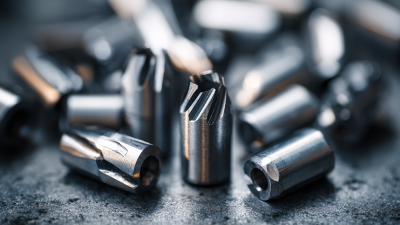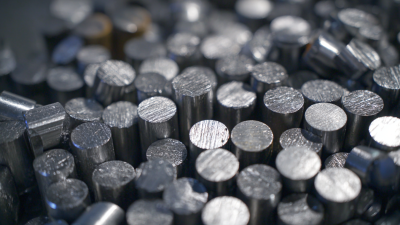Unlock Precision with Indexable Carbide Cutting Tools: Redefining Machining Standards
Table of Contents
- Maximizing Tool Life: The Importance of Indexable Carbide Grade Selection
- Reducing Cycle Times: How Indexable Carbide Tools Enhance Efficiency in Machining
- Precision Engineering: Achieving Tighter Tolerances with Advanced Carbide Inserts
- Cost-Effectiveness of Indexable Carbide Tools: Analyzing ROI in Machining Operations
- Optimizing Cutting Parameters: Data-Driven Tips for Indexable Carbide Tool Performance
- Maximizing Efficiency in Precision Machining: A Review of Taegutec's TNMG160404R-VF CT3000 Ceramic Cutting Inserts
- FAQS
- Conclusion
- Related Posts
In the fast-changing world of machining tech, using indexable carbide cutting tools has really become a game changer. They’re pushing the limits when it comes to precision and efficiency. If you’ve been keeping an eye on industry trends, you probably know that the global market for these tools is expected to hit around $24 billion by 2027. That’s mainly because more manufacturing sectors are on the hunt for high-performance cutting solutions.

Jinan Terry CNC Tool Limited Company is right there in the thick of things, leading the charge as a top exporter of CNC cutting tools in China. By tapping into the advanced capabilities of indexable carbide cutters, manufacturers can get better performance, cut down on downtime, and make their tools last longer. This is really changing the game in machining standards and helping us meet the tough demands of today’s production world.
As automation and precision engineering become more common, you can’t underestimate how crucial innovative cutting tools are to reaching those goals.
Maximizing Tool Life: The Importance of Indexable Carbide Grade Selection
Picking the right indexable carbide grade is super important if you want your tools to last longer and get the best results in machining. Lately, advances in manufacturing have shown that you can really boost cutting tool performance just by fine-tuning the coating, substrate, and shape. For instance, some studies suggest that using specific carbide grades can actually extend the lifespan of your tools by up to 40%, especially when working with tricky materials like LM25 aluminum alloys reinforced with vanadium carbide (LM25Al/VC). That’s a big deal, especially in aerospace where the quality and safety standards are a big deal.
Also, industry reports keep pointing out that the continuous improvements in indexable tooling are key for hitting higher material removal rates (MRR). Take the machining of LM25Al/VC composites, for example — applying analytical models and neural networks has really helped optimize the whole process, saving time and money. End mills, whether for roughing or finishing, are still leading the charge — helping manufacturers crank up productivity and cut down on downtime across different machining tasks. All these tech advancements and smart tool choices mean companies can push the boundaries in efficiency without sacrificing precision or safety—pretty exciting stuff, honestly.
Reducing Cycle Times: How Indexable Carbide Tools Enhance Efficiency in Machining
Indexable carbide cutting tools are really changing the game when it comes to machining – especially by cutting down on cycle times during production. They make it easier to swap inserts quickly, so manufacturers can adapt to different production needs without wasting a bunch of time. Plus, since these tools last longer and generate less waste, they’re actually helping make the machining process more sustainable. All of this adds up to higher productivity and less hassle.
When you combine these tools with advanced machining centers, it’s like a whole new level of manufacturing. Companies are now more focused on optimizing their operations, and smart, model-based productivity strategies are playing a big role in that. They help you make smarter decisions, especially during rough milling, which is pretty important. The whole setup not only boosts efficiency but also lines up nicely with modern sustainability goals. It’s a win-win for manufacturers trying to stay competitive and environmentally conscious at the same time.

Precision Engineering: Achieving Tighter Tolerances with Advanced Carbide Inserts
In the world of precision engineering, pushing for tighter tolerances has really become a key focus for manufacturers who are chasing excellence. It’s crazy to think that the carbide tools market might hit over over $17.3 billion by 2032—no wonder the industry is going through such a big shift, especially with all these advances in carbide inserts. These tools don’t just boost performance; they’re also designed to handle those super intricate machining jobs where precision really matters. As more folks demand better quality components, manufacturers are constantly coming up with new innovations to keep up with these changing standards.

And honestly, the coatings on carbide tools have a huge impact that can’t be overlooked. The latest coatings make tools more resistant to wear and help reduce friction, which means manufacturers can really push the envelope when it comes to precision machining. The newest advancements here are seriously changing what carbide cutting tools can do—think longer-lasting tools and better surface finishes. As machinery gets more advanced, staying ahead means embracing these tech innovations—especially with carbide inserts—to stay competitive in this high-precision game.
Cost-Effectiveness of Indexable Carbide Tools: Analyzing ROI in Machining Operations
When it comes to modern machining, the big deal is often how cost-effective those indexable carbide cutting tools are. I mean, industries are always looking for ways to make their processes smoother and more efficient. Did you know that, according to this recent report by MarketsandMarkets, the global market for these little gadgets is expected to hit around 26.12 billion bucks by 2025? That's roughly a 5.4% yearly growth. A lot of this buzz is because everyone’s craving high-performance tools that can crank out more productivity while cutting down costs. These indexable carbide tools? They’re pretty great because they don’t need to be replaced as often, and they waste less material — so, definitely a smart investment with solid returns.
There’s also a study by Research and Markets pointing out that switching to these tools can bump up machining efficiency by as much as 30% compared to the old-school options. That’s mainly thanks to their clever design, which makes changing tools a quick, hassle-free task and allows using multiple cutting edges. When you're looking at ROI, it’s not just about saving on tool costs — you also have to think about less machine downtime and better quality products. For manufacturers, these benefits really add up and make a noticeable difference on their bottom line. All in all, investing in indexable carbide cutting tools looks like a no-brainer if you’re aiming to optimize your operations and stay ahead of the game.
Unlock Precision with Indexable Carbide Cutting Tools: Redefining Machining Standards - Cost-Effectiveness of Indexable Carbide Tools: Analyzing ROI in Machining Operations
| Parameter | Value | Notes |
|---|---|---|
| Tool Lifespan (hours) | 50 - 100 | Depending on material and cutting conditions |
| Initial Cost per Tool | $30 - $120 | Varies based on type and manufacturer |
| Material Removal Rate (mm³/min) | 150 - 500 | Dependent on tool choice and conditions |
| Cost per Part Produced | $2.00 - $5.00 | Includes labor and material costs |
| Expected ROI (%) | 200 - 300 | Based on increased productivity |
| Setup Time (minutes) | 5 - 15 | Quick and efficient tool changeovers |
| Waste Material (%) | 5 - 10 | Reduced with optimized tool paths |
Optimizing Cutting Parameters: Data-Driven Tips for Indexable Carbide Tool Performance
Indexable carbide cutting tools have really changed the game in the machining world, making it possible for manufacturers to hit those high marks in both precision and efficiency. But to get the most out of these tools, it’s all about tweaking your cutting parameters — stuff like speed, feed rate, and how deep you're cutting. It’s kinda like finding the perfect recipe; a little adjustment here and there can make a big difference.
Here’s a good rule of thumb: start off with what the toolmaker recommends for speeds and feeds. Then, based on the material you’re working with and how fast the tool is wearing out, make small tweaks. For example, when working with softer materials, cranking up the cutting speed can give you a nicer finish and even make your tools last longer. But if you're dealing with tougher, harder materials, it's better to stay on the conservative side — nobody wants those tools burning out too soon.
Oh, and don’t forget about coolant! Using it properly can really boost tool performance. It helps keep everything cool, preventing heat build-up that could damage the tool. Sometimes switching to a better coolant or just adjusting the flow rate can really improve your results and prolong tool life. When you combine all these data-driven strategies, you'll not only work more efficiently but also keep those quality standards high — it's all about working smarter, not just harder.
Maximizing Efficiency in Precision Machining: A Review of Taegutec's TNMG160404R-VF CT3000 Ceramic Cutting Inserts
Maximizing efficiency in precision machining is crucial for manufacturers seeking to enhance productivity and reduce costs. In this context, the Taegutec TNMG160404R-VF CT3000 ceramic cutting inserts stand out due to their advanced design and manufacturing quality. Originating from South Korea, Taegutec is known for its commitment to innovation and excellence in the machining industry. The TNMG160404R-VF CT3000 inserts deliver superior performance when machining materials such as steel, stainless steel, and cast iron, which are prevalent in various industrial applications.
Recent studies have indicated that using high-quality cutting inserts can result in significant improvements in tool life and machining efficiency. For instance, reports suggest that cutting inserts like those from Taegutec can enhance tool lifespan by over 30%, thanks to their robust carbide composition and ceramic properties. This is particularly advantageous when dealing with high-performance tasks, where traditional cutting tools may struggle under thermal and mechanical stress. The versatility of these inserts makes them suitable for a wide range of operations, including turning and milling, thereby providing manufacturers with a comprehensive solution for diverse machining needs.
Furthermore, the integration of advanced cutting tools has been shown to optimize machining parameters, leading to improved surface finish and dimensional accuracy of machined components. Specific industry data indicates that companies adopting high-performance inserts can achieve cycle time reductions of up to 20%, particularly in high-volume production runs. This further underscores the importance of utilizing reliable and efficient cutting tools like the Taegutec ceramic cutting carbide inserts, enabling manufacturers to stay competitive in an increasingly demanding market.
FAQS
: Selecting the appropriate indexable carbide grade is critical for maximizing tool life and achieving optimal machining results, particularly in complex materials.
Certain carbide grades can extend tool lifespan by up to 40%, especially when machining materials like LM25 aluminum alloys reinforced with vanadium carbide.
In aerospace applications, the choice of cutting tools is vital as material properties dictate performance and safety standards.
Advancements in carbide inserts have enabled manufacturers to achieve tighter tolerances and higher precision, which is essential for superior component quality.
Innovative coatings significantly enhance wear resistance and reduce friction, greatly improving the performance and longevity of carbide cutting tools.
Manufacturers can optimize cutting parameters by adjusting cutting speed, feed rate, and depth of cut based on the material and tool wear to enhance performance.
Manufacturers should start with the manufacturer's recommendations and then fine-tune them based on the specific material properties and tool wear circumstances.
Proper coolant application helps to dissipate heat, reducing thermal shock and improving tool longevity, which can significantly enhance overall tool performance.
Effective strategies include adjusting cutting parameters based on material types, monitoring coolant usage, and using high-performance coolants to enhance production quality.
The carbide tools market is expected to exceed $17.3 billion by 2032, driven by continuous innovation and the demand for high precision in machining applications.
Conclusion
The article titled "Unlock Precision with Indexable Carbide Cutting Tools: Redefining Machining Standards" dives into how these tools are really changing the game in modern machining. It stresses how crucial it is to pick the right carbide grade—trust me, that can make all the difference in how long your tools last and how smoothly things run. When you choose the right tools, you can get more consistent performance and cut down on those pesky downtimes. Plus, it’s crazy how much these tools can speed up cycle times, boosting efficiency and overall productivity like never before.
The piece also gets into the nitty-gritty of precision engineering. It shows how top-notch carbide inserts can help you achieve tighter tolerances and better machining results—things that really matter in high-precision work. It even touches on the cost side of things, helping you see the real value and ROI of investing in these tools for your manufacturing setup. To wrap it all up, the article gives some practical, data-backed tips on how to set your cutting parameters just right, so you can make the most out of your indexable carbide tools and get outstanding results every time.
Related Posts
-

How to Choose the Best Carbide Insert for Aluminum Machining
-

7 Unique Features of Stone Cutting Inserts You Should Know
-

Ultimate Guide to Choosing the Right Carbide Cutting Inserts for Your Projects
-

How to Choose the Right Carbide Peeling Insert for Your Machining Needs
-

Why Taegutec Carbide Inserts Enhance Precision and Efficiency in Modern Machining
-

How to Select the Right PDC Blanks for Optimal Drill Bit Performance
Blog Tags:

Amelia
-

Phone
-

E-mail
-

Skype

